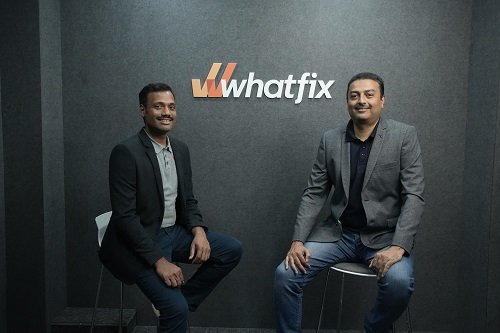Whatfix, the global leader in digital adoption platforms (DAP), today announced the launch of Whatfix AI Agents embedded across its product suite to accelerate user productivity and drive business performance outcomes.
(L–R) Vara Kumar Namburu, Co-founder & Head of R&D and Solutions, Whatfix, and Khadim Batti, Co-founder & CEO, Whatfix
At the heart of these agents is ScreenSense, Whatfix’s proprietary AI technology that continuously interprets both the users’ context within an application and the user’s real-time intent. This understanding powers timely, relevant actions, whether it’s triggering an in-app guide, surfacing enterprise search results, displaying a DAP nudge, or invoking a third-party AI tool. By combining this contextual intelligence with the capabilities of Whatfix AI Agents, users can complete critical tasks faster and more accurately, staying focused on outcomes rather than navigating constant change across the enterprise software stack.
“Gartner projects that software spending will grow at double-digit rates this year, driven by generative AI, yet most enterprises are still struggling to turn these investments into outcomes,” said Khadim Batti, CEO and Co-Founder of Whatfix. “As AI investments increase across the enterprise software stack, many organizations face a growing gap between software’s potential and real user impact. The layer of AI is adding to this rapid change, risking paralyzing users with too much change and too little guidance. Whatfix AI Agents flip that equation. They userize technology to adapt to the user’s context. This is not just about improving adoption. It is about enabling every user to succeed in an environment where systems are changing faster than people can keep up.”
Whatfix AI Agents—Powered by ScreenSense:
The first three Whatfix AI Agents—Authoring, Insights, and Guidance—are now available across the Whatfix product suite, transforming how enterprises create, analyze, and guide in-app experiences. Powered by ScreenSense, they interpret application context and user intent in real time to deliver precise, high-value actions that accelerate work.
Authoring Agent: This agent removes friction from the content creation process by generating fully configured in-app experiences using simple natural language prompts, including pop-ups, walkthroughs, and advanced visibility rules. It enables anyone responsible for creating guidance content — such as training teams, and application or product owners — to publish at scale without needing any technical expertise.
Example: Make a tip appear when users land on a new dashboard. Just add a prompt in natural language and the Authoring Agent will generate the content, apply targeting logic, and style it automatically.
Insights Agent: This agent is a conversational interface that transforms how users interact with their product analytics data. It helps stakeholders across functions ask questions in natural language to uncover user behavior and drop-off patterns. These insights enable product owners to identify product features that need enhancements or better adoption.
Example: Ask a question like, “How is the new workflow performing?” The Insights Agent returns a clear visual summary, highlights friction points, and recommends the next best step — all in seconds.
Guidance Agent: This agent delivers precise, AI-generated answers in the flow of work, distilling complex or lengthy knowledge into short, contextual summaries. It transforms how users access information, reducing time-to-answer and supporting dependency. It is designed to support enterprise users who need clarity fast, without switching tabs, reading long documents, or escalating to support.
Example: When a user searches for “return policy exceptions” while working in an order management system, the Guidance Agent instantly surfaces a concise summary from internal documentation, right within the application, with no context switch required.
Deeply embedded across Digital Adoption, Product Analytics, and Mirror, these agents form an intelligent layer that personalizes every user interaction—bridging the gap between enterprise systems and user success at scale.
Laurentiu BOGDAN, Operational Excellence Director at Servier, said, “With Whatfix AI, we’re heading towards a world where digital solutions will self-correct, self-improve, and personalize in real time, based on user intent. It’s not just about automation; it’s about making complexity disappear.”
What’s Next for Whatfix AI
Building on its leadership in Digital Adoption, Whatfix is expanding into AI-first products designed to deliver measurable business impact. The company will continue to advance its Userization philosophy—putting technology in service of the user—by integrating intelligent automation, real-time discovery, and adaptive training into its product suite. These innovations aim to create a unified, AI-powered experience where every user can succeed, no matter how fast enterprise systems evolve. This trajectory is reflected in industry recognition: Whatfix won the 2025 AI Breakthrough Award as “Overall AI-based Analytics Solution of the Year” and has been shortlisted for the AI Awards for “Best Use of AI for Learning,” with winners to be announced in September.
To explore Whatfix AI Agents and schedule a live demo, visit: whatfix.com/ai
About Whatfix
Whatfix is an AI platform advancing the “userization” of enterprise applications—empowering companies to maximize the ROI of their digital investments. Powered by a proprietary AI engine ScreenSense, Whatfix continuously interprets “Application Workflow Context” and “User Intent” to boost user productivity, ensure process compliance, and elevate user experience across applications. The product portfolio includes a Digital Adoption Platform (DAP), Mirror simulated application environments for hands-on training, and Product Analytics for no-code insights. With seven offices across the US, India, UK, Germany, Singapore, and Australia, Whatfix supports 700+ enterprises, including 80+ Fortune 500s like Shell, Schneider Electric, and UPS Supply Chain Solutions. Backed by investors such as Warburg Pincus, Softbank Vision Fund 2, Dragoneer, Peak XV Partners, Eight Roads, and Cisco Investments, software clicks with Whatfix.























